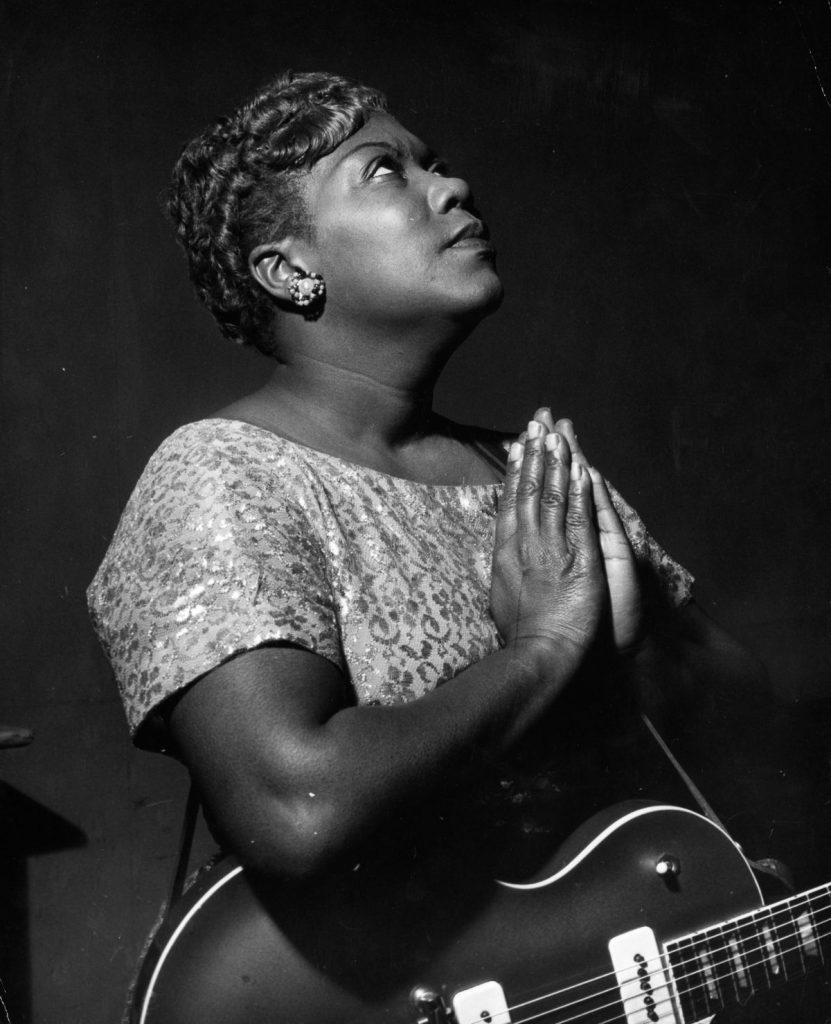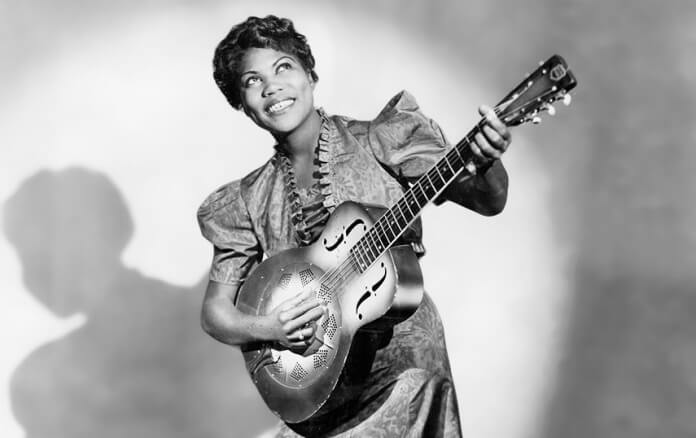Sister Rosetta Tharpe – A Complete Biography
Introduction
Sister Rosetta Tharpe (1915–1973) was a gospel singer, electric-guitar trailblazer, and one of the most consequential architects of early rock ’n’ roll. Long before the rise of Elvis Presley, Chuck Berry, or Little Richard, Tharpe fused sanctified lyrics with driving, blues-inflected rhythms and a ferocious, highly amplified guitar attack, helping gospel cross over to mainstream audiences and setting the sonic template that rock players would adopt for decades. In recognition of this formative impact, she was inducted into the Rock & Roll Hall of Fame in 2018 as an Early Influence.

Childhood
Born Rosetta Nubin on March 20, 1915, in Cotton Plant, Arkansas, Tharpe grew up in a devout Pentecostal household, where music was inseparable from worship. Her mother, Katie Bell Nubin, was an evangelist, singer, and mandolin player associated with the Church of God in Christ (COGIC), a denomination that encouraged rhythmic expression and welcomed women in musical leadership—conditions that nurtured Rosetta’s precocious talent. By age six she was performing publicly alongside her mother and was widely regarded as a musical prodigy.
Youth
Traveling on the evangelistic circuit through the American South and Midwest, the young “Little Rosetta Nubin” refined a style that mixed virtuosic guitar runs with call-and-response singing. In her early twenties she moved to New York, signed with Decca Records, and—on October 31, 1938—cut her first sides (“Rock Me,” “That’s All,” “My Man and I,” “The Lonesome Road”). Appearances that year at Harlem’s Cotton Club and John Hammond’s landmark “Spirituals to Swing” concert at Carnegie Hall brought her both fame and controversy for presenting gospel material in secular venues.
Adulthood
Through the 1940s Tharpe recorded and toured relentlessly, at times fronting or guesting with big swing outfits like Lucky Millinder’s orchestra. Her performances, which paired spiritual themes with dance-band energy and searing guitar, captivated club audiences while unsettling some churchgoers—yet she remained rooted in gospel throughout her career. With pianist Sammy Price she cut “Strange Things Happening Every Day” (recorded late 1944), the first gospel record to become a major crossover hit, reaching No. 2 on Billboard’s “race records” chart in April 1945; many historians cite it as a key precursor—and even a candidate for the first—rock ’n’ roll record.
In 1951 Tharpe staged one of the most remarkable public events in American popular music: she married her manager Russell Morrison in Washington, D.C.’s Griffith Stadium and turned the ceremony into a ticketed concert; contemporary reports place attendance around 20,000.
Her influence only deepened in the 1950s–60s. She toured the U.K. and Europe, inspiring a generation of British guitarists who later powered the blues-rock boom, and in May 1964 appeared on Granada Television’s famed “Blues and Gospel Train,” filmed at a disused Manchester railway station—an electrifying performance (notably “Didn’t It Rain”) widely shared and re-broadcast in later decades.
Major Compositions (Recordings)
- “Rock Me” (1938): One of her debut Decca sides, spotlighting the blend of gospel message and blues phrasing that became her hallmark and influenced later rock vocalists.
- “This Train” (1939): A traditional number she popularized with propulsive rhythm and crisp, single-note guitar lines.
- “Strange Things Happening Every Day” (1944/45): A crossover smash often cited as foundational to rock ’n’ roll.
- “Up Above My Head” (late 1940s, with Marie Knight): A joyous, guitar-driven duet that became one of her signatures on stage and record.
- “Down by the Riverside” (1948): Celebrated for its spirited vocal and guitar work, underscoring her crossover influence.
- “Didn’t It Rain” (1964): The televised Manchester performance cemented her legend for later generations.
Death
Tharpe’s health declined at the start of the 1970s. She suffered a stroke in 1970 and, due to complications from diabetes, had a leg amputated. She died of another stroke on October 9, 1973, in Philadelphia, aged 58. She was later honored with a U.S. postage stamp, induction into the Blues Hall of Fame in 2007, and the Rock & Roll Hall of Fame in 2018—formal acknowledgments of a towering legacy.
Conclusion
Sister Rosetta Tharpe’s career rewrote the boundaries of sacred and secular sound. Her amplified tone, fearless stagecraft, and rhythmic guitar vocabulary anticipated and shaped rock ’n’ roll—so much so that leading figures from Little Richard and Johnny Cash to British blues greats have pointed to her as a formative influence. Today she stands not just as the “Godmother of Rock ’n’ Roll,” but as a central figure in American musical modernity whose recordings continue to sound startlingly contemporary.

Comments are closed